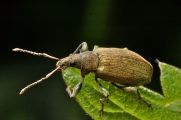Підтримуємо Вільну Україну
 We Support Free Ukraine
We Support Free Ukraine

Biodiversity Map
Taxa

-
Arthropodaphylum
Click to switch
to select orders
and filters > -
Hexapodasubphylum
Click to switch
to select orders
and filters > -
Insectaclass
Click to switch
to select orders
and filters > -
Coleopteraorder
Click to set
as the main taxon
and as a base
← of the left panel > -
Polyphagasuborder
Click to set
as the main taxon
and as a base
← of the left panel > -
Cucujiformiaseries
Click to set
as the main taxon
and as a base
← of the left panel > -
Curculionoideasuperfamily
Click to set
as the main taxon
and as a base
← of the left panel > -
Curculionidaefamily
Click to set
as the main taxon
and as a base
← of the left panel > -
Entiminaesubfamily
Click to set
as the main taxon
and as a base
← of the left panel > -
Phyllobiinitribe
Click to set
as the main taxon
and as a base
← of the left panel > -
Phyllobiusgenus
Click to set
as the main taxon
and as a base
← of the left panel > -
Metaphyllobiussubgenus
Click to set
as the main taxon
and as a base
← of the left panel >
species:
Phyllobius (Metaphyllobius) glaucus
PL
YES
name status: valid name
BioMap ID: 1046638
taxon code: 5045
taxonomy checked: YES
Data on distribution in Poland

Statistics
- Records: 767
- Publications: 154
- Collections: 27
- Publication authors: 105
- Illustrations (iconography): 1
- Photos (specimen/observation): 3
Taxon description
Gatunek rozpowszechniony niemal w całej Europie oraz na Syberii (prócz obszarów północnych), podawany również z Algierii i jako zawleczony do Kanady. W Polsce pospolity, rozsiedlony od wybrzeży Bałtyku aż po Sudety i cały łuk karpacki, gdzie występuje często w piętrze regla dolnego i połonin. Zasiedla wilgotne i zimne środowiska — zacienione doliny rzek i potoków, lasy podmokłe, bagna i torfowiska. Bionomia poznana fragmentarycznie; rozwój nie znany. Postacie dojrzałe poławiano od połowy kwietnia do lipca, w górach do sierpnia. Żeruje na liściach głównie krzewów i drzew, rzadziej roślin zielnych; piśmiennictwo podaje przeszło 20 gatunków roślin żywicielskich.
Illustrations
... browse
 Phyllobius
Phyllobiusglaucus
External data sources
- Ostatnie rekordy
-
1100101
 ×
× Curculionidae: Phyllobius glaucus, PL, Ndl. Ruda, Branica, 1939, leg. A. Gottwald, coll. IBL, Zakład Ochrony Lasu, Sękocin: Gottwald
Curculionidae: Phyllobius glaucus, PL, Ndl. Ruda, Branica, 1939, leg. A. Gottwald, coll. IBL, Zakład Ochrony Lasu, Sękocin: Gottwald -
1100100
 ×
× Curculionidae: Phyllobius glaucus, PL, Ndl. Ruda, 1939, leg. A. Gottwald, coll. IBL, Zakład Ochrony Lasu, Sękocin: Gottwald
Curculionidae: Phyllobius glaucus, PL, Ndl. Ruda, 1939, leg. A. Gottwald, coll. IBL, Zakład Ochrony Lasu, Sękocin: Gottwald -
1100099
 ×
× Curculionidae: Phyllobius glaucus, PL, Ndl. Ruda, 1939, leg. A. Gottwald, coll. IBL, Zakład Ochrony Lasu, Sękocin: Gottwald
Curculionidae: Phyllobius glaucus, PL, Ndl. Ruda, 1939, leg. A. Gottwald, coll. IBL, Zakład Ochrony Lasu, Sękocin: Gottwald -
1100098
 ×
× Curculionidae: Phyllobius glaucus, PL, Ndl. Ruda, 1939, leg. A. Gottwald, coll. IBL, Zakład Ochrony Lasu, Sękocin: Gottwald
Curculionidae: Phyllobius glaucus, PL, Ndl. Ruda, 1939, leg. A. Gottwald, coll. IBL, Zakład Ochrony Lasu, Sękocin: Gottwald -
1100097
 ×
× Curculionidae: Phyllobius glaucus, PL, Ndl. Ruda, 1939, leg. A. Gottwald, coll. IBL, Zakład Ochrony Lasu, Sękocin: Gottwald
Curculionidae: Phyllobius glaucus, PL, Ndl. Ruda, 1939, leg. A. Gottwald, coll. IBL, Zakład Ochrony Lasu, Sękocin: Gottwald -
1099943
 ×
× Curculionidae: Phyllobius glaucus, PL, Białowieski P.N., Białowieża, 1937, leg. A. Gottwald, coll. IBL, Zakład Ochrony Lasu, Sękocin: Gottwald
Curculionidae: Phyllobius glaucus, PL, Białowieski P.N., Białowieża, 1937, leg. A. Gottwald, coll. IBL, Zakład Ochrony Lasu, Sękocin: Gottwald -
1099942
 ×
× Curculionidae: Phyllobius glaucus, PL, Białowieski P.N., Białowieża, 1937, leg. A. Gottwald, coll. IBL, Zakład Ochrony Lasu, Sękocin: Gottwald
Curculionidae: Phyllobius glaucus, PL, Białowieski P.N., Białowieża, 1937, leg. A. Gottwald, coll. IBL, Zakład Ochrony Lasu, Sękocin: Gottwald -
1099941
 ×
× Curculionidae: Phyllobius glaucus, PL, Białowieski P.N., Białowieża, 1937, leg. A. Gottwald, coll. IBL, Zakład Ochrony Lasu, Sękocin: Gottwald
Curculionidae: Phyllobius glaucus, PL, Białowieski P.N., Białowieża, 1937, leg. A. Gottwald, coll. IBL, Zakład Ochrony Lasu, Sękocin: Gottwald -
1099940
 ×
× Curculionidae: Phyllobius glaucus, PL, Ndl. Białowieża, 1937, leg. A. Gottwald, coll. IBL, Zakład Ochrony Lasu, Sękocin: Gottwald
Curculionidae: Phyllobius glaucus, PL, Ndl. Białowieża, 1937, leg. A. Gottwald, coll. IBL, Zakład Ochrony Lasu, Sękocin: Gottwald -
1099939
 ×
× Curculionidae: Phyllobius glaucus, PL, Białowieski P.N., Białowieża, 1937, leg. A. Gottwald, coll. IBL, Zakład Ochrony Lasu, Sękocin: Gottwald
Curculionidae: Phyllobius glaucus, PL, Białowieski P.N., Białowieża, 1937, leg. A. Gottwald, coll. IBL, Zakład Ochrony Lasu, Sękocin: Gottwald - ... more
- Powiązane publikacje
-
Mazur M.A. 2011c. Weevils (Coleoptera: Curculionoidea) of the Stobrawski Landscape Park. Pol. Pismo Ent., 80(2):321-342.
 full text
full text Show records
Show records -
Jaskuła R., Przewoźny M., Melke A. 2009a. Chrząszcze (Coleoptera). [In:] Jaskuła R., Tończyk G. (Eds.) Owady (Insecta) Spalskiego Parku Krajobrazowego, Część I. Mazowiecko-Świętokrzyskie Towarzystwo Ornitologiczne, Spała. pp. 27-59.
 Show records
Show records -
Pawłowski J.S., Kubisz D. 2008. Chrząszcze Ojcowskiego Parku Narodowego i otuliny. [In:] Klasa A., Partyka J. (Eds.) Monografia Ojcowskiego Parku Narodowego. Przyroda. Ojców. pp. 553-576.
 Show records
Show records -
Sprick P., Floren A. 2007. Canopy leaf beetles and weevils in the Białowieża and Borecka Forests in Poland (Col., Chrysomeloidea, Curculionoidea). Pol. Pismo Ent., 76:75-100.
 Show records
Show records -
Renner K., Messutat J. 2007. Untersuchungen zur Käferfauna der Umgebung von Skwierzyna im westlichen Polen (Wielkopolska). Coleo, 8:16-20.
 Show records
Show records - ... more
- Powiązane zbiory
-
ISEZ PAN
 Show records
Show records -
Jeno P.
 Show records
Show records -
Malkin B.*
 Show records
Show records -
MiIZ PAN
 Show records
Show records -
MiIZ PAN: Tenenbaum Sz.
 Show records
Show records - ... more
- Wykaz powiązanych pozycji
-
Curculionoidea of Poland
 Show records
Show records -
Weevils of the Tatra Mts.
 Show records
Show records








